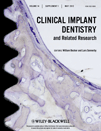A Comparison of Fit of CNC-Milled Titanium and Zirconia Frameworks to Implants
ABSTRACT
Background: Computer numeric controlled (CNC) milling was proven to be predictable method to fabricate accurately fitting implant titanium frameworks. However, no data are available regarding the fit of CNC-milled implant zirconia frameworks.
Purpose: To compare the precision of fit of implant frameworks milled from titanium and zirconia and relate it to peri-implant strain development after framework fixation.
Materials and Methods: A partially edentulous epoxy resin models received two Branemark implants in the areas of the lower left second premolar and second molar. From this model, 10 identical frameworks were fabricated by mean of CNC milling. Half of them were made from titanium and the other half from zirconia. Strain gauges were mounted close to the implants to qualitatively and quantitatively assess strain development as a result of framework fitting. In addition, the fit of the framework implant interface was measured using an optical microscope, when only one screw was tightened (passive fit) and when all screws were tightened (vertical fit). The data was statistically analyzed using the Mann–Whitney test.
Results: All frameworks produced measurable amounts of peri-implant strain. The zirconia frameworks produced significantly less strain than titanium. Combining the qualitative and quantitative information indicates that the implants were under vertical displacement rather than horizontal. The vertical fit was similar for zirconia (3.7 µm) and titanium (3.6 µm) frameworks; however, the zirconia frameworks exhibited a significantly finer passive fit (5.5 µm) than titanium frameworks (13.6 µm).
Conclusions: CNC milling produced zirconia and titanium frameworks with high accuracy. The difference between the two materials in terms of fit is expected to be of minimal clinical significance. The strain developed around the implants was more related to the framework fit rather than framework material.




